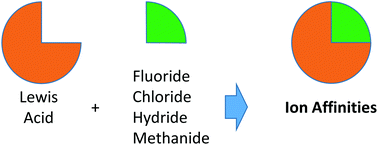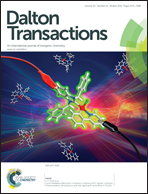From unsuccessful H2-activation with FLPs containing B(Ohfip)3 to a systematic evaluation of the Lewis acidity of 33 Lewis acids based on fluoride, chloride, hydride and methyl ion affinities†
Abstract
The possibility of obtaining frustrated Lewis pairs (FLPs) suitable for H2-activation based on the Lewis acid B(Ohfip)31 (Ohfip = OC(H)(CF3)2) was investigated. In this context, the crystal structure of 1 as well as the crystal structure of the very weak adduct 1·NCMe was determined. When reacting solutions of 1 with H2 (1 bar) and selected phosphanes, amines, pyridines and N-heterocyclic carbenes, dihydrogen activation was never observed. Without H2, adduct formation with 1 was observed to be an equilibrium process, regardless of the Lewis base adduct. Thus, the thermodynamics of H2 activation of 1 in comparison with the well-known B(C6F5)3 was analyzed using DFT calculations in the gas phase and different solvents (CH2Cl2, ortho-difluorobenzene and acetonitrile). These investigations indicated that FLP chemistry based on 1 is considerably less favored than that with B(C6F5)3. This is in agreement with control NMR experiments indicating hydride transfer from [H–B(Ohfip)3]− upon reaction with B(C6F5)3, giving [H–B(C6F5)3]− and B(Ohfip)3 in toluene and also MeCN. Induced by these unsuccessful reactions, the Lewis acidity towards HSAB hard and soft ions was investigated for gaining a deeper insight. A unified reference system based on the trimethylsilyl compounds Me3Si–Y (Y = F, Cl, H, Me) and their respective ions Me3Si+/Y− calculated at the G3 level was chosen as the anchor point. The individual ion affinities were then assessed based on subsequent isodesmic reactions calculated at a much less expensive level (RI-)BP86/SV(P). This method was validated by systematic calculations of smaller reference systems at the frozen core CCSD(T) level with correlation effects extrapolated to a full quadruple-ζ basis. Overall, 33 common and frequently used Lewis acids were ranked with respect to their FIA, CIA, HIA and MIA (fluoride/chloride/hydride/methyl ion affinity).

- This article is part of the themed collection: In memory of Professor Kenneth Wade

 Please wait while we load your content...
Please wait while we load your content...